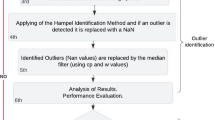Abstract
Novel time–frequency (t–f) methods are developed for the detection of non-stationary signals in the presence of noise with uncertain power. The proposed method uses instantaneous frequency estimation and de-chirping procedure to convert a non-stationary signal into a stationary signal, thus allowing us to exploit temporal correlation as an extra feature for signal detection in addition to the signal energy. The proposed method can be used for both mono-sensor and multi-sensor recordings. Area under receiver operating characteristic curve and probability of signal detection are used as criteria for comparing the performance of the proposed signal detection methods with the state of the art in the presence of noise power uncertainty. Simulation results indicate the superiority of the proposed approach.











Similar content being viewed by others
References
S. Ali, J.A. Lopez-Salcedo, G. Seco-Granados, Improved GLRT based on the exploitation of spatial correlation between neighbouring sensors, in Proceedings of 19th EUSIPCO, pp. 1045–1049 (2011)
S. Ali, G. Seco-Granados, J.A. Lopez-Salcedo, Spectrum sensing with spatial signatures in the presence of noise uncertainty and shadowing. EURASIP J. Wirel. Commun. Netw. 2013, 150 (2013)
S. Ali, D. Ramírez, M. Jansson, G. Seco-Granados, J.A. López-Salcedo, Multi-antenna spectrum sensing by exploiting spatio-temporal correlation. EURASIP J. Adv. Signal Process. 2014(1), 1–16 (2014)
T.W. Anderson, An Introduction to Multivariate Statistical Analysis, vol. 2, 2nd edn. (Wiley, New York, 2003)
W.G. Anderson, R. Balasubramanian, Time-frequency detection of gravitational waves. Phys. Rev. D 60(10), 102001 (1999)
E. Axell, G. Leus, E.G. Larsson, H.V. Poor, Spectrum sensing for cognitive radio: state-of-the-art and recent advances. IEEE Signal Process. Mag. 29(3), 101–116 (2012)
B. Barkat, B. Boashash, A high-resolution quadratic time-frequency distribution for multicomponent signals analysis. IEEE Trans. Signal Process. 49(10), 2232–2239 (2001)
B. Boashash, Estimating and interpreting the instantaneous frequency of a signal. II. Algorithms and applications. Proc. IEEE 80(4), 540–568 (1992)
B. Boashash, G. Azemi, A review of time–frequency matched filter design with application to seizure detection in multichannel newborn EEG. Digit. Signal Process. 28, 28–38 (2014)
B. Boashash, V. Sucic, Resolution measure criteria for the objective assessment of the performance of quadratic time–frequency distributions. IEEE Trans. Signal Process. 51(5), 1253–1263 (2003)
S. Chen, X. Dong, Z. Peng, W. Zhang, G. Meng, Nonlinear chirp mode decomposition: a variational method. IEEE Trans. Signal Process. 65(22), 6024–6037 (2017)
I. Djurović, A WD-RANSAC instantaneous frequency estimator. IEEE Signal Process. Lett. 23(5), 757–761 (2016)
I. Djurovic, QML-RANSAC: PPS and FM signals estimation in heavy noise environments. Signal Process. 130(Supplement C), 142–151 (2017)
S.S. Haykin, J. Litva, T.J. Shepher, Radar Array Processing (Springer, New York, 1993)
N.A. Khan, M. Sandsten, Time–frequency image enhancement based on interference suppression in Wigner–Ville distribution. Signal Process. 127, 80–85 (2016)
O. Ledoit, M. Wolf, Some hypothesis tests for the covariance matrix when the dimension is large compared to the sample size. Ann. Stat. 30(4), 1081–1102 (2002)
N. Lu, D.L. Zimmerman, The likelihood ratio test for a separable covariance matrix. Stat. Probab. Lett. 73(5), 449–457 (2005)
S. Meignen, D.-H. Pham, S. McLaughlin, On demodulation, ridge detection, and synchrosqueezing for multicomponent signals. IEEE Trans. Signal Process. 65(8), 2093–2103 (2017)
M. Mohammadi, A.A. Pouyan, N.A. Khan, A highly adaptive directional time–frequency distribution. Signal Image Video Process. 10(7), 1369–1376 (2016)
J.M. O’Toole, B. Boashash, Time-frequency detection of slowly varying periodic signals with harmonics: methods and performance evaluation. EURASIP J. Adv. Signal Process. 2011(1), 193797 (2011)
S.J. Shellhammer, S. Shankar, R. Tandra, J. Tomcik, Performance of power detector sensors of DTV signals in IEEE 802.22 WRANs, in Proceedings of 1st International Workshop on Technology and policy for accessing spectrum (TAPAS), pp. 4–13 (2006)
P.-L. Shui, Z. Bao, S. Hong-Tao, Nonparametric detection of FM signals using time–frequency ridge energy. IEEE Trans. Signal Process. 56(5), 1749–1760 (2008)
J. Simmons, Echolocation in bats: signal processing of echoes for target range. Science 171(974), 925–928 (1971)
L.J. Stankovic, I. Djurovic, A. Ohsumi, H. Ijima, Instantaneous frequency estimation by using Wigner distribution and Viterbi algorithm, in 2003 IEEE International Conference on Acoustics, Speech, and Signal Processing, 2003. Proceedings.(ICASSP’03), Vol. 6. IEEE, pp. VI–121 (2003)
R. Tandra, A. Sahai, SNR walls for signal detection. IEEE J. Sel. Top. Signal Process. 2(1), 17–24 (2008)
E. Visotsky, S. Kuffner, R. Peterson, On collaborative detection of TV transmissions in support of dynamic spectrum sharing, in Proceedings of 1st IEEE DySPAN, pp. 338–345 (2005)
S. Wang, X. Chen, G. Cai, B. Chen, X. Li, Z. He, Matching demodulation transform and synchrosqueezing in time–frequency analysis. IEEE Trans. Signal Process. 62(1), 69–84 (2014)
W. Yang, G. Durisiand, V.I. Morgenshtern, E. Riegler, Capacity pre-log of SIMO correlated block-fading channels, in 8th International Symposium Wireless Communication Systems (ISWCS), pp. 869–873 (2011)
Y. Yang, X. Dong, Z. Peng, W. Zhang, G. Meng, Component extraction for non-stationary multi-component signal using parameterized de-chirping and band-pass filter. IEEE Signal Process. Lett. 22(9), 1373–1377 (2015)
Y. Zeng, Y.C. Liang, Eigenvalue-based spectrum sensing algorithms for cognitive radio. IEEE Trans. Commun. 57(6), 1784–1793 (2009)
Y. Zeng, Y.-C. Liang, Spectrum-sensing algorithms for cognitive radio based on statistical covariances. IEEE Trans. Veh. Technol. 58(4), 1804–1815 (2009)
Y. Zeng, Y.-C. Liang, A.T. Hoang, R. Zhang, A review on spectrum sensing for cognitive radio: challenges and solutions. EURASIP J. Adv. Signal Process. 2010, 381465 (2010). https://doi.org/10.1155/2010/381465
Author information
Authors and Affiliations
Corresponding author
Rights and permissions
About this article
Cite this article
Khan, N.A., Ali, S. Exploiting Temporal Correlation for Detection of Non-stationary Signals Using a De-chirping Method Based on Time–Frequency Analysis. Circuits Syst Signal Process 37, 3136–3153 (2018). https://doi.org/10.1007/s00034-018-0825-5
Received:
Revised:
Accepted:
Published:
Issue Date:
DOI: https://doi.org/10.1007/s00034-018-0825-5




